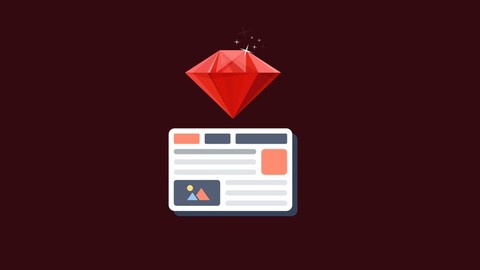
Coding for Beginners: Using Ruby Programming language
Coding for Beginners: Using Ruby Programming language, available at $49.99, has an average rating of 3.75, with 37 lectures, based on 2 reviews, and has 1952 subscribers.
You will learn about Install Ruby Interact with Ruby in various ways Ruby Gems Working with Numbers Working with Strings Working with Arrays Working with Boolean Data Type Conditional statements Using Loops Using Break statements Using various types of operators This course is ideal for individuals who are Beginners to Ruby or Beginners to coding It is particularly useful for Beginners to Ruby or Beginners to coding.
Enroll now: Coding for Beginners: Using Ruby Programming language
Summary
Title: Coding for Beginners: Using Ruby Programming language
Price: $49.99
Average Rating: 3.75
Number of Lectures: 37
Number of Published Lectures: 37
Number of Curriculum Items: 37
Number of Published Curriculum Objects: 37
Original Price: $29.99
Quality Status: approved
Status: Live
What You Will Learn
- Install Ruby
- Interact with Ruby in various ways
- Ruby Gems
- Working with Numbers
- Working with Strings
- Working with Arrays
- Working with Boolean Data Type
- Conditional statements
- Using Loops
- Using Break statements
- Using various types of operators
Who Should Attend
- Beginners to Ruby
- Beginners to coding
Target Audiences
- Beginners to Ruby
- Beginners to coding
Ruby is an interpreted, high-level, general-purpose programming language which supports multiple programming paradigms. It was designed with an emphasis on programming productivity and simplicity. In Ruby, everything is an object, including primitive data types.
Unlike languages such as C and C++, a scripting language doesn’t talk directly to hardware. It’s written to a text file and then parsed by an interpreter and turned into code. These programs are generally procedural in nature, meaning they are read from top to bottom.
Object-oriented languages, on the other hand, break out pieces of code into objects that can be created and used as needed. You can reuse these objects in other parts of the program, or even other applications.
Ruby is a dynamic, open source programming language with a focus on simplicity and productivity. It has an elegant syntax that is natural to read and easy to write.
Ruby is seen as a flexible language, since it allows its users to freely alter its parts. Essential parts of Ruby can be removed or redefined, at will. Existing parts can be added upon.
This course will teach you the basic fundamentals of the Ruby programming language.
Topics covered include:
-
Ruby Gems
-
Installing Ruby
-
Interacting with Ruby
-
Arrays
-
Variables and Variable scope
-
Strings
-
Ruby Symbols
-
Ruby Constants
-
Logical Operators
-
Comparison Operators
-
Arithmetic Operators
-
Ranges
Course Curriculum
Chapter 1: Installing and Interacting with Ruby
Lecture 1: Introduction
Lecture 2: Please Read
Lecture 3: What is Ruby
Lecture 4: Downloading Ruby for Windows
Lecture 5: Installing Ruby on Windows
Lecture 6: Introduction to ways of interacting with Ruby
Lecture 7: Interacting with Ruby using single command
Lecture 8: Interactive Ruby
Lecture 9: Clearning and Exiting IRB Screen
Lecture 10: Interacting with Ruby with a File
Chapter 2: Ruby Fundamentals
Lecture 1: Ruby Gems
Lecture 2: Basic Gem Commands
Lecture 3: Ruby Objects
Lecture 4: Variables in Ruby
Lecture 5: Ruby Variable Scope
Lecture 6: Ruby Constant
Lecture 7: Ruby Numbers
Lecture 8: Ruby Arrays
Lecture 9: Ruby Strings
Lecture 10: Boolean Data Type
Lecture 11: Manipulating Arrays
Lecture 12: Ruby Symbols
Lecture 13: Ruby Hashes
Lecture 14: Ruby Arithmetic Operators
Lecture 15: Ruby Logical Operators
Lecture 16: Comparison Operators
Lecture 17: Ruby Ranges
Lecture 18: Using Comments in Ruby
Lecture 19: While loops
Lecture 20: For loops
Lecture 21: Break Loop statement
Lecture 22: next loop statement
Lecture 23: Conditional statements
Lecture 24: Until Loop statement
Lecture 25: What is Http
Lecture 26: Create a simple Ruby Program
Lecture 27: Thank You
Instructors
-
Bluelime Learning Solutions
Making Learning Simple
Rating Distribution
- 1 stars: 0 votes
- 2 stars: 0 votes
- 3 stars: 1 votes
- 4 stars: 1 votes
- 5 stars: 0 votes
Frequently Asked Questions
How long do I have access to the course materials?
You can view and review the lecture materials indefinitely, like an on-demand channel.
Can I take my courses with me wherever I go?
Definitely! If you have an internet connection, courses on Udemy are available on any device at any time. If you don’t have an internet connection, some instructors also let their students download course lectures. That’s up to the instructor though, so make sure you get on their good side!
You may also like
- Best Yoga Instruction Courses to Learn in March 2025
- Best Stress Management Courses to Learn in March 2025
- Best Mindfulness Meditation Courses to Learn in March 2025
- Best Life Coaching Courses to Learn in March 2025
- Best Career Development Courses to Learn in March 2025
- Best Relationship Building Courses to Learn in March 2025
- Best Parenting Skills Courses to Learn in March 2025
- Best Home Improvement Courses to Learn in March 2025
- Best Gardening Courses to Learn in March 2025
- Best Sewing And Knitting Courses to Learn in March 2025
- Best Interior Design Courses to Learn in March 2025
- Best Writing Courses Courses to Learn in March 2025
- Best Storytelling Courses to Learn in March 2025
- Best Creativity Workshops Courses to Learn in March 2025
- Best Resilience Training Courses to Learn in March 2025
- Best Emotional Intelligence Courses to Learn in March 2025
- Best Time Management Courses to Learn in March 2025
- Best Remote Work Strategies Courses to Learn in March 2025
- Best Freelancing Courses to Learn in March 2025
- Best E-commerce Strategies Courses to Learn in March 2025






















